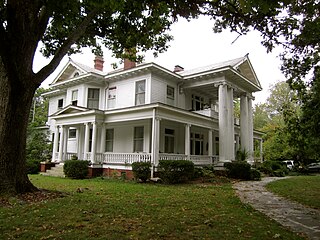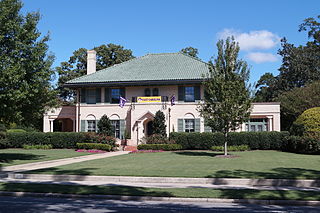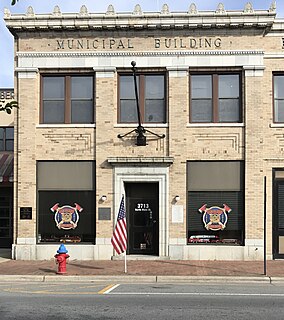
Gales Ferry is a village in the town of Ledyard, Connecticut, United States. It is located along the eastern bank of the Thames River. The village developed as a result of having a ferry to Uncasville located at this site, and from which the village was named. Gales Ferry was listed as a census-designated place for the 2010 Census, with a population of 1,162.

The Montford Area Historic District is a mainly residential neighborhood in Asheville, North Carolina that is included in the National Register of Historic Places.

The Shepard Street–South Road Street Historic District is a national historic district located at Elizabeth City, Pasquotank County, North Carolina. The district encompasses 161 contributing buildings in a historically African-American section of Elizabeth City. The district developed from the mid-19th to mid-20th century, and includes representative examples of Greek Revival, Gothic Revival, Italianate, Queen Anne, Colonial Revival, Bungalow, and American Foursquare style architecture. Notable contributing buildings include the Sawyer–Pailin–Overman House, Antioch Presbyterian Church, (former) St. Catherine Catholic Church (1941), Olive Branch Missionary Baptist Church (1904), Corner Stone Missionary Baptist Church (1888), (former) St. Phillips Episcopal Church (1893), the Sundry Shop, Rex Cleaning Works (1932), Good Samaritan Hall (1896), and Republican Star Odd Fellows Hall.

The Vogel Place Historic District is a nationally recognized historic district located in Ottumwa, Iowa, United States. It was listed on the National Register of Historic Places in 1995. At the time of its nomination it contained 158 resources, which included 101 contributing buildings, six contributing structures, and 51 non-contributing buildings.

The Monroe Residential Historic District is a national historic district located at Monroe, Union County, North Carolina. It encompasses 376 contributing buildings, 1 contributing site, and 4 contributing objects in a predominantly residential section of Monroe. The district developed between about 1874 and 1940 and includes notable examples of Italianate, Queen Anne, and Classical Revival architecture styles and includes work by architects Wheeler & Stern and by G. Marion Tucker. Notable buildings include the R. V. Houston House, Houston-Redfearn House, the Belk House, J. H. Lee House, M. G. Sheppard House, Elizabeth Friedeman House, former Methodist Parsonage, Gaston Meares House, William E. Cason House, M. G. Sheppard House, and George B. McClellan House.

The College View Historic District is a national historic district located north of East Carolina University at Greenville, Pitt County, North Carolina. The district encompasses 343 contributing buildings in a predominantly residential section of Greenville. It includes buildings dated from about 1909 to World War II and notable examples of Bungalow / American Craftsman, Colonial Revival, and Tudor Revival architecture. Notable buildings include St. Paul's Episcopal Church (1930), the Rotary Club Building (1921), Chancellor's Residence, William Harrington House, Bateman House (1910), Franklin Vines Johnston House (1923), and Dr. Paul Fitzgerald House (1929).

Riverside Historic District is a national historic district located at New Bern, Craven County, North Carolina. It encompasses 101 contributing buildings and 4 contributing sites developed as a suburban residential neighborhood in New Bern between 1894 and 1921. The district is characterized by dwellings in the Classical Revival, Queen Anne, and Bungalow / American Craftsman styles. Notable non-residential buildings include the Riverside Graded School, Riverside United Methodist Church, S. B. Parker Company Building, Sadler's store, and Hawkins Grocery Store.

Cooleemee Mill Town Historic District is a national historic district located at Cooleemee, Davie County, North Carolina. The district encompasses 433 contributing buildings, 1 contributing site, and 6 contributing structures on the original Cooleemee Cotton Mill Company property at Cooleemee. It was developed between 1898 and 1967, and includes notable examples of Gothic Revival, American Craftsman, and Colonial Revival style architecture. Notable contributing resources include the mill houses of 12 house types, Cooleemee Cotton Mill complex, Pest House and the company farm, Friendship Baptist Church, North Cooleemee Elementary School (1952), Church of the Good Shepherd (1925), Cooleemee United Methodist Church (1932), First Baptist Church of Cooleemee (1949), Cooleemee Recreation Center Bathhouse (1949), “The Holler,” and “Riverside Park,” also known as “Park Hill.”

West End Historic District is a national historic district located at Winston-Salem, Forsyth County, North Carolina. The district encompasses 508 contributing buildings and 7 contributing structures, in a predominantly residential section of Winston-Salem. It was a planned picturesque streetcar suburb developed at the turn of the 20th century. The buildings date from about 1887 to 1930, and include notable examples of Classical Revival, Colonial Revival, Queen Anne, and Bungalow / American Craftsman style architecture. Located in the district are the separately listed H. D. Poindexter Houses and Zevely House. Other notable buildings include the St. Paul's Episcopal Church (1928-1929) designed by Ralph Adams Cram, Augsburg Lutheran Church (1926), Friends Meeting House (1927), the First Church of Christ, Scientist (1924), and Joyner's West End Grocery.

Irving Park Historic District is a national historic district located at Greensboro, Guilford County, North Carolina. The district encompasses 164 contributing buildings, 5 contributing sites, 2 contributing structures, and 2 contributing objects in an affluent planned suburb of Greensboro. It developed around the Greensboro Country Club. The houses were largely built between 1911 and the 1930s and include notable examples of Colonial Revival, Tudor Revival, and Classical Revival-style architecture. Notable buildings include the first Robert Jesse Mebane House, the Cummins A. Mebane House, the Lynn Williamson House, the first J. Spencer Love House, the Aubrey L. Brooks House, Carl I. Carlson House, the Van Wyck Williams House, the Lavlson L. Simmons House, the Albert J. Klutz House, the Irving Park Manor Apartments, McAdoo-Sanders-Tatum House, the Alfred M. Scales House, and the Herman Cone House.

Downtown Sanford Historic District is a national historic district located at Sanford, Lee County, North Carolina. It encompasses 53 contributing buildings in the central business district of Sanford. The district includes notable examples of Colonial Revival, Tudor Revival and Art Deco style architecture, with buildings largely dated between about 1895 to 1930. Located in the district are the separately listed Railroad House and Temple Theatre. Other notable buildings include the Sanford Buggy Company, McCracken Building, Passenger Depot, City Hall, Coca-Cola Bottling Company, Masonic Lodge, Makepeace Building (1924), Wilrick Hotel (1925), Bowers Building, Cole Pontiac Building, Hubbards Shoe Store (1926), Carolina Hotel (1930), and former U. S. Post Office.

Carthage Historic District is a national historic district located at Carthage, Moore County, North Carolina. The district encompasses 85 contributing buildings, 1 contributing site, 5 contributing structures, and 1 contributing object in a predominantly residential section of Carthage. It was developed between the 1850s and 1940 and includes notable examples of Queen Anne, Greek Revival, and Colonial Revival style architecture. Notable buildings include the Carthage Methodist Church (1898-1900), (former) Carthage Community House (1939-1940) built by the National Youth Administration, the "Chub" Seawell House, Edgehill, Charles Sinclair House, Dr. John Shaw House, Humber-Spencer House, Adams-Bryan House, Jenkins House, Harley-Muse House (1879), George Calvin Graves House, W. T. Jones House (1897), the J. F. Cole House (1899), the Methodist Parsonage (1922), and Presbyterian Manse.

Nashville Historic District is a national historic district located at Nashville, Nash County, North Carolina. It encompasses 142 contributing buildings and 3 contributing structures in the rural county seat of Nashville. The buildings primarily date between 1890 and 1930, and include notable examples of Greek Revival, Italianate, Queen Anne, Colonial Revival, and Classical Revival style architecture. Located in the district are the separately listed Bissette-Cooley House and Nash County Courthouse. Other notable buildings include Joyner's Recreation, Graphic Building, Baldy Batchelor Livery Stable, Weldon's Department Store (1913), Nashville Fire Department (1930), Ricks-Strickland House (1890s), Squire Harper House (1868), two metal-veneered "Lustron houses," Neville-Strickland House (1907), Primitive Baptist Church, First Methodist Church (1923), and former Baptist Church.

Northside Historic District is a national historic district located at Elizabeth City, Pasquotank County, North Carolina. The district encompasses 398 contributing buildings in a predominantly residential section of Elizabeth City. The district developed from the mid-19th to mid-20th century, and includes representative examples of Greek Revival, Queen Anne, Colonial Revival, Bungalow / American Craftsman, and Classical Revival style architecture. Notable contributing buildings include the John S. Burgess House, Scott-Culpepper House, Luther C. Lassiter House (1908-1913), William F. Williams House (1908-1914), Miles Pritchard House, Mack N. Sawyer House (1895), the Godfrey-Foreman House, Dr. Walter W. Sawyer House (1915), City Road United Methodist Church (1900-1902), Blackwell Memorial Baptist Church (1902), former Elizabeth City High School (1923), and S. L. Sheep School (1940).

Elizabeth City State Teachers College Historic District is a national historic district located on the campus of Elizabeth City State University at Elizabeth City, Pasquotank County, North Carolina. The district encompasses six contributing buildings and one contributing site originally built for the State Colored Normal School at Elizabeth City. The buildings are in the Colonial Revival and Bungalow / American Craftsman architectural styles. The contributing resources are the campus quadrangle; Moore Hall ; G. R. Little Library, later, Thorpe Administration Building, now H. L. Trigg Building ; Bias Hall (1937-1939), Butler Hall ; and the Practice School.

Elizabeth City Historic District is a national historic district located at Elizabeth City, Pasquotank County, North Carolina. The district encompasses 592 contributing buildings, 1 contributing site, 1 contributing structure, and 1 contributing object in the central business district and surrounds residential sections of Elizabeth City. The district developed after 1789, and includes representative examples of Greek Revival, Federal, and Late Victorian style architecture. Notable contributing buildings include the Grice-Fearing House (1789-1808), Shirley Armstrong House, Goodman-Matthews-Pool House, Dr. William Martin House, Pool-Kennedy-Lumsden House, Charles-Hussey House, Richardson-Pool House, North Carolina Building (1859), Cobb Building, the former First Methodist Church, Christ Episcopal Church (1857), J. W. Dent House, Dr. Butt's Drug Store, the McMullen Building, the Lowrey Building, former Citizens Bank, Robinson Building (1903), Kramer Building (1909), Selig Building (1925), the Virginia Dare Hotel and Arcade (1927), First Baptist Church (1889), United States Post Office and Courthouse, and Pasquotank County Courthouse (1882).

Elizabeth City Water Plant is a historic municipal water plant located at Elizabeth City, Pasquotank County, North Carolina. The complex includes the contributing Elizabeth City Water Plant Building, Coagulation Basin (1926), Raw Water Pump House, the Circular Finished Water Reservoir (1926), and the Raw Water Reservoir. The Elizabeth City Water Plant Building is a Mission Revival style brick building sheathed in stucco and built in 1926. It consists of a projecting three-bay three-story central pavilion flanked on each side by identical two-story blocks. It is topped by a broad hipped roof covered by green clay tiles.

Farmville Historic District is a national historic district located at Farmville, Pitt County, North Carolina. The district encompasses 330 contributing buildings, 1 contributing site, and 2 contributing structures in the central business district and surrounding residential sections of Farmville. It includes buildings dated from about 1860 to 1942 and notable examples of Colonial Revival, Classical Revival, and Queen Anne style architecture. Notable buildings include the James W. May House, Fields-Rasberry House, Dr. David Morrill House, Warren Parker House, Nannie Smith House, First Christian Church (1910), Emmanuel Episcopal Church (1920), St. Elizabeth Catholic Church, Municipal Building (1928) possibly designed by Benton & Benton, Bank of Farmville (1921) designed by Benton & Benton, Pollard Auto Company Building, Paramount Theatre (1930s), J. Y. Monk Tobacco Warehouse, and East Carolina Railway Office and Freight Station.

Salisbury Historic District is a national historic district located at Salisbury, Rowan County, North Carolina. The district encompasses 348 contributing buildings and 1 contributing site in the central business district and surrounding residential sections of Salisbury. It includes notable examples of Late Victorian, Colonial Revival, and Bungalow / American Craftsman style architecture. Located in the district are the separately listed Maxwell Chambers House, McNeely-Strachan House, Archibald Henderson Law Office, and the former Rowan County Courthouse. Other notable buildings include the tower of the former First Presbyterian Church (1891-1893), Rowan County Courthouse (1914), Conrad Brem House, Kluttz's Drug Store, Bell Building, Washington Building, Grubb-Wallace Building, Hedrick Block, Empire Hotel, St. Luke's Episcopal Church (1827-1828), Soldiers Memorial A.M.E. Zion Church (1910-1913), U.S. Post Office and Courthouse (1909), City Hall (1926), Salisbury Fire House and City Building (1897).

Mordecai Place Historic District is a historic neighborhood and national historic district located at Raleigh, North Carolina. The district encompasses 182 contributing buildings and 1 contributing object in the most architecturally varied of Raleigh's early-20th century suburbs for the white middle-class. Mordecai Place was listed on the National Register of Historic Places in February 1998, with a boundary increase in 2000.






















